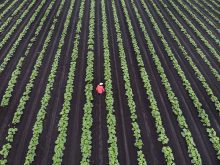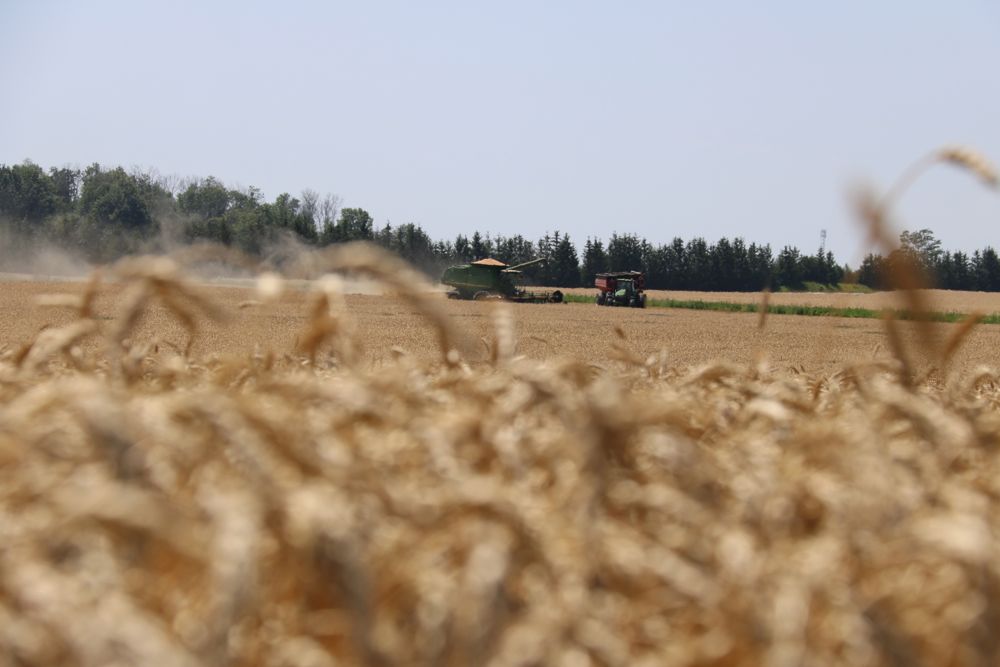It’s got to be the toughest question in today’s agriculture. What’s the optimum farm size? For a lot of experts — and a lot of farmers — there’s a simple one-word answer. Bigger. Or maybe we should make that, BIGGER. But Shawn McRae isn’t buying it, and although McRae isn’t the kind to try to tell other farmers how to run their own farms, he can’t see how anyone can get onto the expansion treadmill until they’ve maximized their profitability first.
It’s all in the delicate balance between modern-day technology and traditional farm wisdom, says McRae, a popular speaker during the winter months who is never shy about sharing what he knows and what he’s experienced. It’s an openness that has helped him win a number of accolades too, including the BASF Innovative Farmer of the Year award presented at the 2012 Innovative Farmers Association of Ontario annual meeting in February.
Read Also

Could crop sharing be a viable option for your farm?
Crop sharing could be a good option for young and beginning farmers.
In fact, McRae knows that he’s in the spotlight enough to make some farmers wonder if he’s there mainly for the ego. It’s an idea though that takes him aback, running contrary to what he sees as the fundamental nature of farming.
“Farming is a great occupation to nurture self-doubt,” McRae tells me. And then he adds that he goes to great lengths to avoid comparing himself to other growers.
Instead, the thing that takes him to more and more meetings and into more and more educational programs, he says, is that the issues surrounding today’s agriculture are just so cool. Or, as he frequently repeats as we talk, “I eat, breathe and sleep this stuff!”
He knows he isn’t the only one. “If we’re careful to use disciplined, objective and scientific analyses of our systems and our goals,” McRae says, “we can gain reassurance in our decision-making process and avoid rash mistakes borne of insecurity.
“Definitely, the way I approach the business and the lifestyle and the science of farming is all rolled up into one big ball of wax,” McRae adds. “I don’t compartmentalize different aspects, it has to all blend together.”
High yields, low costs
McRae works the family farm along the St. Lawrence River near the Quebec border, where the 800-acre operation is nestled beside the hamlet of Bainsville. His great-grandfather grew up and farmed at a location farther north in the same county, and purchased the current plot at auction in 1904. McRae now works 450 acres, with a five-crop rotation that includes roughly 90 acres each of corn, dry beans, oats, soybeans and barley.
The other 350 acres include woodlots, wetlands, grass headlands and buffer strips, along with some land that is being transitioned into crop production.
For the record, his corn yields are at a five-year average of 178 bushels per acre, with a 15-year trendline increase of 4.5 bushels per acre per year. At the same time, he applies only 100 lbs. of fertilizer N per acre, with no P and K or starter fertilizer.
In the production of adzuki beans, McRae has managed to push production to 22 cwt per acre without fertilizer versus the Ontario average of 17 to 18 cwt per acre, typically with fertilizer. And he has the lab analyses to show that his manure and compost applications are replenishing lost nutrients. Roughly one-eighth of the cropland has a manure or compost application, equivalent to 1.5 tonnes per acre, worth 13 lbs. of total nitrogen (N), 13.5 lbs. of phosphate and 9.25 lbs. of potash.
Keeping it simple
In an era when expansion and being among the first to buy the latest technology are seen as the twin pillars of success, McRae is a holdout. For him, change doesn’t come quickly. It is planned, analysed and examined from all angles. And when it’s found to work and provide an economic payback, it’s accepted as a new management norm.
The McRae farm has been in conservation-till production since 1983, when Shawn’s father Ron permanently parked his furrow plow. Shawn was 12 when that happened, and by 1988, despite some early growing pains with their chisel plow, the operation was a combination of no-till and ridge-till farming. There is no fall tillage done, although McRae now performs what he terms strategic mulch tillage in the spring before corn. For that task, he uses a mix of old and new, with an old Ford disc that provides the tillage and a tractor equipped with RTK GPS auto-steer guidance to help manage compaction using controlled wheel traffic.
(For next year, McRae is planning to eliminate his spring tillage and move it back to August after barley. Then he’ll rebuild the ridges and seed cover crops similar to what he does following oats, and he’ll go back to planting corn no till on a ridge. McRae believes this will reduce holdups with corn planting and reduce the risk of erosion from any heavy spring rains.)
After graduating from the University of Guelph in agronomy in 1995, McRae became a partner in the family farm operation, and the learning has continued since then. He’s attended seminars and conferences and he has researched the economic and environmental impacts of no till to the point where he has managed to reduce his fertilizer use, boost his yields and help improve the overall health of the soil on the farm.
“This change to no till that my dad undertook took place when I was a pretty impressionable teenager,” says McRae. He adds that it bothered him to see the frustration on his father’s face, trying to remediate the rill and gully erosion that was taking place on the farm. “So I did my high school science project on soil erosion and soil degradation, and then went on to university from there to study it further. For me, soil without a blanket of protection, whether it be a cover crop or at least the crop residue, is prone and threatened.”
In the shop too
Just as McRae justifies what he does on the soil, he uses the same reasoning when it comes to his machinery. To say something is old isn’t a reason to replace it. If it works — and in this case, if it works well — then keep it. That’s why McRae uses the same Hiniker ridge-till corn planter with Kinze units that his dad used back in the 1990s. For cereals, he uses a 22-run, 15-foot no-till Tye drill, complete with a coulter cart he purchased in 2003. The fluted coulters on the unit break up the surface after 30-inch ridge-tilled beans.
McRae has also outfitted the Hiniker ridge-till cultivator to seed cover crops such as red clover, oilseed radish and annual ryegrass, using grass seed boxes from the Tye drill, a 40-year-old windshield wiper motor and some equally vintage bicycle parts. The modification provides an opportunity to rebuild the ridges following oats, while spreading a cover crop after harvest.
The goal, he explains, is to take a common-sense approach while still adopting the latest technology in terms of glyphosate-tolerant corn, GPS auto-steer, and RTK. “You name it, if it’s new and it represents a competitive advantage or a competitive tweak, I’ll adopt it or work it in,” says McRae. “But I’m not going to throw the baby out with the bathwater and go back to making the same mistakes that have been made in the past with respect to too much tillage, too much dependence on bank credit and too much artificial fertilizer and artificial pest control. We still need the fundamentals of crop management and crop rotation, so I’m just trying to establish that balance and incorporate as much modern science as I can.”
There’s even a “back-to-basics” approach when it comes to heating the family farm operation. McRae manages the farm’s woodlot acreage, removing deadfalls, diseased or wind-damaged trees plus fenceline trimmings, grinds them down using a Hurricane wood chipper and burns it all in a furnace that’s capable of heating two homes (including hot water), an office, machine shop, woodshop and an insulated machine shed.
The system is driven by a homemade electric-hydraulic powerpack and an old truck transmission, and not only allows for fine tuning the fuel and air blending in the primary combustion chamber, it also comes with a timer-controlled feed of grain screenings from their seed cleaner unit. The system is completely self-sufficient.
It starts with the soil
On top of the economic aspects of soil management, there is also the science of soil which has to be factored into the management equation. Informing this complex decision-making process is McRae’s insatiable appetite for information. This past winter, he spent time educating himself on the complexities of Keynesian economic theory versus Austrian economic theory. He also has a business associate who scans the news services of the world every morning, and during the course of the day, sends him news items and economic updates, sometimes to inform and sometimes to stimulate new lines of thinking.
“As a farmer, I just read and attempt to continually educate myself in all of those parameters, from global economics and how they impact the financial system, to our markets and credit supply,” McRae says. “It just comes in and goes through your grey matter, and what comes out the other end, in terms of management of the business or the soil, is just a culmination of that.”
To say that McRae does not jump to conclusions or make decisions about managing his farm based on convention or a whim is an understatement. He studies, he challenges, he revises and tweaks — and he worries about whether he’s made the right decision.
Blending old and new
That curious blend of common sense and technology — of old and new — drives McRae’s world, particularly where soil sustainability is concerned. McRae has studied soil health, right down to its microbiological levels since the fall of 2002, when he attended the National No-Till Conference in Indianapolis.
It was at that conference that he heard from the likes of U.S. researchers Jill Clapperton and the late Dean Martens, and realized that there’s a little-understood, unappreciated world living in the soil, and that its sustainability has a direct cause-and-effect impact on the sustainability that farmers try to build into their operations.
Today, he continues to learn of the role that fungi play in the soil profile, affecting plant-available nutrients, soil aggregate stability, cation-exchange capacity (CEC) and enhancing crop growth. With his schooling at Guelph, he realized that much of what is known about soil science is based on conventional plow-till systems, and from sessions with Clapperton, Martens and others, he came to learn that soil biology changes significantly under no till. It reached the point that after switching to no-till and ridge-till farming, McRae and his father stopped seeing any appreciable response to applied in-furrow liquid starter fertilizer.
Now he wonders if the main tenets in the belief in expansion leading to profitability are wrong. The 2010 Large Commercial Producer Study, commissioned as a joint project between Agri-Studies Inc. and Ipsos Forward Research, established the low end of the large commercial producer class to be $250,000 in annual revenues. It’s arguable that most people involved in the agri-food/agribusiness sector would think a farm of 450 acres is too small to yield enough to reach that level. Yet McRae’s revenues are well above that mark, and his costs, including fertilizer, are lower than those of many of his counterparts.
“I wonder sometimes if the cause and effect is backwards. Perhaps it’s the individuals driving the business who are successful, and expansion is the consequence,” poses McRae. “Another component is that expansion takes timing; a whole bunch of things have to come together for that to be good. That’s why I study history and I study financial markets, I want to step back and be objective, and ask, ‘Is now the time to expand or will there be buy opportunities around the corner?’ I’ve seen some people expand and fail rapidly.”
For now, McRae is happy with what he has and how he’s producing. He’s comfortable with his equipment and the fact that his bins fit his acreage, and he has a debt-to-equity ratio that’s manageable. The sustainability that he’s worked to build on the farm is something that helps him manage with efficiency, and will help if any of his children decide that they want to farm as well. Or he can help them as they head off into another career choice.
“We can liquidate, we can rent and I can help set them up in some other business, whatever interests them,” says McRae. “Or they can go off on their own, make their own way in life. Whatever makes them happy, that’s what I want in the future.
“And that’s another reason I don’t want expansion for the sake of expansion… things can backfire on you.” CG















